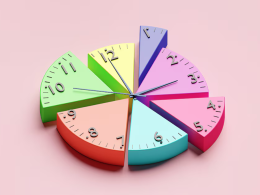Top 15 app makers see 20% drop in downloads
by John Natale, Wells Fargo Asset Management
Stocks dipped lower on a slow news day for the markets.
The Dow fell 19 points, with 16 of its 30 components retreating; the S&P 500 Index slipped by 3 points; and the Nasdaq lost 16. Decliners topped advancers by five to three on the NYSE and by nine to four on the Nasdaq. The prices of Treasuries strengthened. Gold futures rose $10.40 to close at $1,272.70 an ounce. The price of crude oil fell 67 cents, settling at $50.56 a barrel.
In other business news:
- Initial jobless claims fell 4,000 to a seasonally adjusted 264,000 last week. According to the Labor Department, the four-week moving average of claims—which irons out weekly volatility—declined 7,500 to 277,000. The number of people continuing to receive unemployment benefits decreased 77,000 to 2.1 million, an almost 16-year low.
- Wholesale inventories rose 0.6% in April from March’s upwardly revised 0.2% gain, according to the Commerce Department. Wholesale sales climbed 1.0% following the prior month’s 0.6% increase. The component of wholesale inventories that is factored into U.S. gross domestic product—inventories minus autos—advanced 0.8%.
- The People’s Bank of China’s chief economist projected China’s economy will grow 6.8% in 2016. The outlook gels with a new report from the central bank’s research bureau forecasting that growth will fall within Beijing’s target range of 6.5% to 7.0%.
- China also issued its Producer Price Index, which showed that wholesale price deflation pressures eased in May. The index fell 2.8% in May from April’s 3.4% decline. Chinese manufacturers are still in deflationary territory but contracting at a slower pace.
- Regarding consumer inflation, China’s National Bureau of Statistics said today that the nation’s Consumer Price Index rose 2.0% in May from a year earlier following April’s 2.3% increase. Among the key drivers of easing consumer inflation: a 21% drop in vegetable prices from the prior month.
*****
 Pop quiz: How many apps does the average U.S. smartphone user download per month? According to tech blog Recode,
Pop quiz: How many apps does the average U.S. smartphone user download per month? According to tech blog Recode,![]() the answer is zero.
the answer is zero.
Mobile app publishers big and small are witnessing growth grind to a halt as smartphone users—who’ve been downloading apps since Apple opened its app store in 2008—realize they might not need any more apps on their phones. Research firm Nomura says, in May, the top 15 app publishers saw app downloads plummet 20% on average in the U.S. from a year earlier. This includes Facebook, Twitter, and YouTube, whose app downloads declined 14.9%, 18.6%, and 20.1%, respectively.
What’s driving the download declines? Does everyone suddenly hate apps? Is it dawning on people that you only need so many ways to message friends, buy things, consume video, and subscribe to people’s stream-of-conscious punditry, jokes, and slacktivism?
When it comes to social media–focused apps, the download decline may indicate a behavioral shift. According to research firm SimilarWeb,![]() people are also spending far less time using the social media apps they’ve already downloaded onto their phones. In a study that compared Android users’ habits in the first quarter of 2016 from a year ago, SimilarWeb uncovered the following trends among U.S. users:
people are also spending far less time using the social media apps they’ve already downloaded onto their phones. In a study that compared Android users’ habits in the first quarter of 2016 from a year ago, SimilarWeb uncovered the following trends among U.S. users:
- Instagram: down 36.2%
- Twitter: down 27.9%
- Snapchat: down 19.2%
- Facebook: down 6.7%
Is the “Must …check … my news feed … over and over!” habit beginning to fade?
Or maybe social media app users are just becoming more efficient and have narrowed their typical social media habits to a smaller range of actions. I haven’t received one of those invites to play “Mafia Farmvilles with Friends” video games in my Facebook feed for more than a year … Could the drop in Facebook usage be due to people spending less time on in-app games?
The decline in overall app downloads could also be a symptom of market saturation.
Apple and Android’s app stores have a combined 3.1 million different apps you can download, and the new apps keep coming. As with most products’ and services’ life cycles, the honeymoon phase can only last so long. At some point, producers need to differentiate themselves from the pack to survive, with offerings that tackle an unmet need, challenge, or problem. Case in point: Apple’s 1.5-million-strong app store has about 150,000 “book” apps.
How many different apps does the world need to consume a book? You’d think at the 100,000-app mark, boutique shops and startups might have said: “You know what? Let’s make something else.”
While app makers struggle with cooling growth rates, there’s one shining star in the Apple app store that has defied all logic to grow downloads by the millions. Cookie-maker Oreo has a video game app![]() called “Twist, Lick, Dunk” that’s drawn more than 4 million downloads with 250,000 peak daily active users and 70 million game sessions played since the app’s launch.
called “Twist, Lick, Dunk” that’s drawn more than 4 million downloads with 250,000 peak daily active users and 70 million game sessions played since the app’s launch.
Somewhere, Mark Zuckerberg is reading this column and comparing Facebook and Instagram’s declining app downloads with the Oreo app’s improbable growth. And, I’d like to think, he’s typing an instant message to the social media giant’s lawyers, saying: “Hey lawyers, it’s Zuck. Can we buy Oreo? No, not a package of cookies … I mean, can we buuuuy Oreo? We need that app!”
Copyright © Wells Fargo Asset Management
















